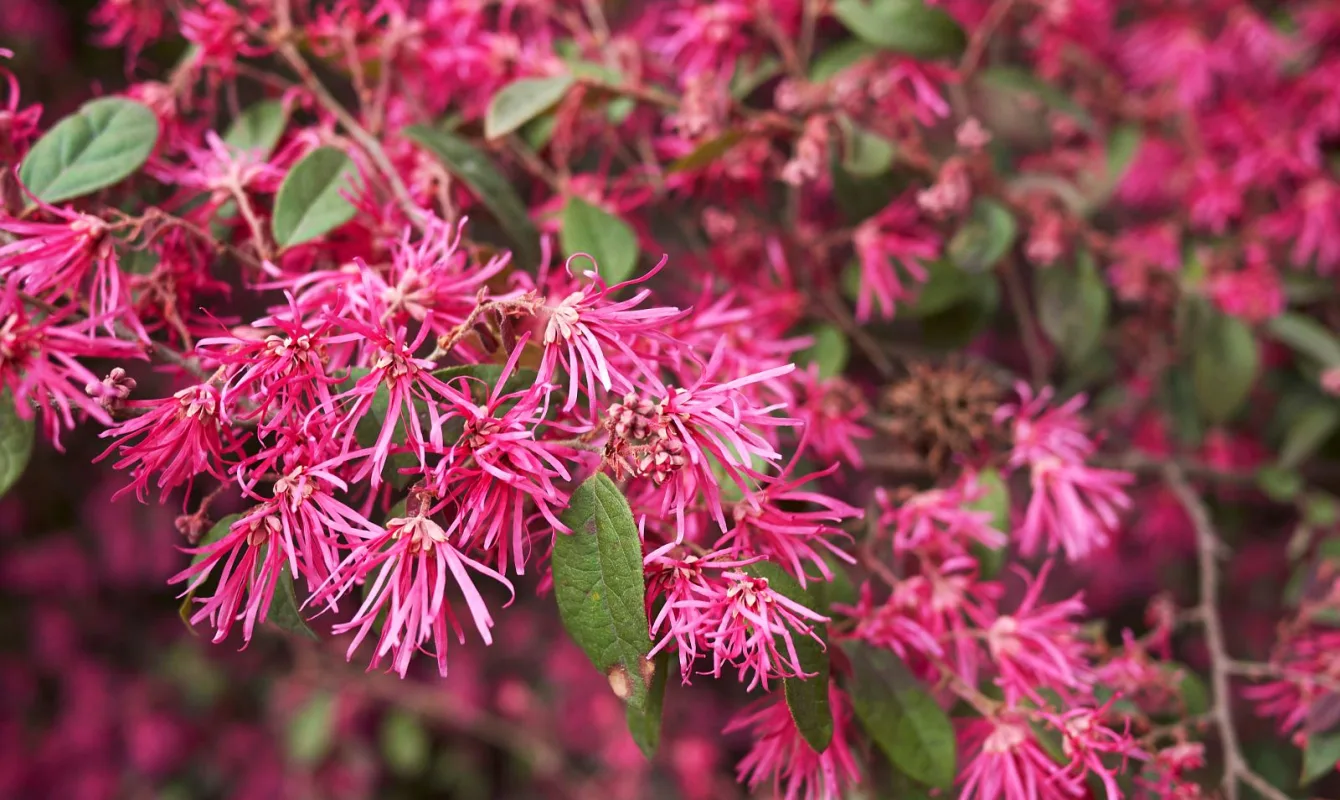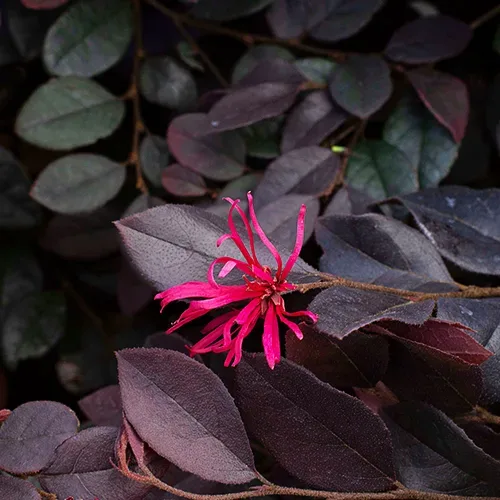
Written by s • Fringe Flowers – Everything You Need to Know About Loropetalum
I remember well the first time I saw a red Fringe Flower bush. Even as a pretty knowledgeable gardener I was blown away, so I understand why this plant has become such a hot ‘must have’ for so many gardeners in warmer zones. Maybe you too just saw one for the first time, and of course thought, “I want that in my garden!” Who wouldn’t? The most popular are those with red foliage and flowers, because ‘all-red’ shrubs are rare, and red foliage is way ahead of all other colors as the most popular for garden specimen plants. Called Fringe Flowers or Loropetalum, (their botanical name), these eye-catchers have really taken off, so let’s take a closer look at these plants, and how to grow them.
Tips on Loropetalum
- Ideal for zones 7, 8 and 9. Grow in western zone 10 as well
- Very adaptable to light – full sun to full shade
- Love woodlands – but drought resistant too
- Very easy to grow – no wonder they are popular
- Great for containers – grow well for years in planter and pots
What are Fringe Flowers (Loropetalum)?
The Chinese Fringe Flowers has been known to specialist gardeners for a long time, but it has only been in the last couple of decades that they have risen to public interest. It is related to the witch-hazel (Hamamelis), which many people know from its yellow flowers on bare branches through fall, winter and early spring, depending on the variety. Witch hazels grow in both North America and China, but Fringe Flowers grow wild only in China, although they are widely grown in gardens in Japan too. Called by botanists Loropetalum chinense, this plant was for 100 years only seen in the west in a form with green leaves. An attractive evergreen, the rounded leaves grow horizontally from the stems, and the plant forms in time a large bush or small tree, usually with a vase-shaped form. Most garden plants are smaller, between 3 and 10 feet tall, depending on the variety, and the age of the plant. The unique blooms are like those of the witch-hazel, in clusters, with narrow, strap-like petals. They are white to yellow.
Since around 1990 a form that was already well-known in China and Japan was brought to America. This is the natural variety, found in the wild, called ‘rubrum’, making its full name Loropetalum chinense var. rubrum. It has red leaves, and pink flowers, and it was this plant that catapulted the Fringe Flower from ‘specialist collector plant’ into the top-seller it is today. Bright, eye-catching young plants proved irresistible to gardeners, and they have been planted through the South and West.
Caring for the Fringe Flower

Gardeners were also surprised to discover just how easy the Loropetalum is to grow. Although it naturally grows in woodlands, in moist, slightly-acidic soil, well-drained soil, it proved very tough, and grows just as well in ordinary garden soil, and in full sun all the way to woodland shade. It is perfectly hardy in zones 7, 8 and 9, all across the country, and it also grows in zone 10 in California, where summers are drier, but not in the same zone in southern Florida. There the summers are just too humid for it. Some afternoon shade is helpful in zones 9 and 10, but this plant proved to be remarkably drought-resistant, and very trouble-free, with no pests or diseases of any note. Of course, the usual provision with drought-resistance applies – you need to spend at least the first growing season caring for your new plant, with regular watering – probably weekly, or even twice-weekly in a sunny spot – to establish it well before it will show that toughness in dry weather.
Where to Grow Loropetalum
Woodland gardens, or areas beneath deciduous trees, are still the best plant to put your new Fringe Flower. They have a natural form that fits well, and they certainly brighten it up. If you are planting in shade, and want red leaves, then consider your variety carefully, as some are inclined to fade in summer. The form called Ever Red® is highly regarded by experts, exactly because it doesn’t fade in the shade, or with the passing of the seasons, but stays rich burgundy all the time.
There is a tendency to just use plain evergreens around the house, often neatly trimmed. Consider adding plants like the Loropetalum to those areas – their foliage shows well against the rich greens, and their more casual growth contrasts perfectly with those rounded forms. That touch of color really lifts your foundation planting to a new level you will love – for no extra work.
Fringe Flowers are also perfect for larger planter boxes and tubs. Because they are so colorful you don’t even need to plant anything else, and they live for years, with regular watering and fertilizer. In colder parts of zone 7 they may not be so suitable, as winter lows could cause root damage, but in other zones they will be just fine.
Varieties of Fringe Flowers for the Garden
The interest in the red-leaf Loropetalums also attracted attention to their ignored green-leaf forms. Not only are they beautiful on their own, but when planted with the red forms they make a great show together, and a terrific color contrast that makes those reds and pinks really pop. Among the best are Carolina Moonlight® and Snow Dance™, both reaching 6 to 8 feet, or even more if unpruned. The first has creamy yellow flowers, and the second is, like its name, pure white. The smaller variety Emerald Snow™ has the advantage of smaller size if you have limited space, plus some fall re-blooming, as well as showy lime-green new growth in spring – all making this a great pick.
Of course, it is the red-leaved forms that are the big hit. The first ones were called ‘Blush’ and ‘Burgundy’, and they had pinkish or bronze new growth, and bright pink flowers, so they looked fabulous in spring. Sadly, they turn greenish to bronzy-green in summer, so there time as the center of attention is limited. This doesn’t mean they are not worth growing, especially as larger shrubs, but since those early days they have been superseded by newer forms. If you only have room for a bush to 3 feet tall and wide, then look out for ‘Crimson Fire’, which has good color, and great hardiness at the colder end of zone 7, and perhaps into zone 6. ‘Daruma’ is another good one, with more purplish leaves, which keep their color pretty well, and a size that probably won’t go over 6 feet.
For pink flowers on full-sized bushes, consider Fire Dance® and Little Rose Dawn®, but saving the best for last, if you want red rather than pink flowers, which all the varieties already mentioned have, than the top pick has to be Ever Red®, which we already mentioned for its durable red foliage. Combine that with bright red flowers, a compact habit, and over-all toughness, and it has to be the pick of the bunch.





